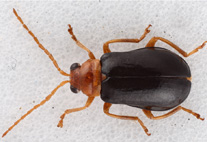Abstract
The mangrove crab Aratus pisonii (H. Mile Edwards, 1837) was considered to have an amphi-American distribution but a recent genetic study revealed that the Eastern Tropical Pacific populations represent a new species, A. pacificus (Thiercelin & Schubart, 2014). These sister species separated by the Central American Isthmus have developed under different environmental conditions that may influence their larval development. A comparison of morphological and morphometric features (length and width of cephalothorax and length of rostral and dorsal spine, antenna, antennule, telson, and furcae) of recently-hatched larvae of A. pacificus (Pacific coast) and A. pisonii (Caribbean coast) from Costa Rica revealed that the setation pattern of the antennules differed between the species and the analyzed morphometric features were larger in A. pisonii larvae. Difference in size may be a response to different environmental conditions, as the lower primary production in coastal Caribbean waters, which may have forced females of A. pisonii to allocate more energy into the offspring, resulting in larger zoeal size. A greater endogenous reserve may allow the larvae to reduce the duration of the planktonic phase and increase the size at metamorphosis, thus enhancing their survival chances during the planktonic phase. These data regarding morphological and morphometric differences in recently-hatched larvae of the Pacific and Caribbean species support the conclusion that specimens of Aratus from both coasts of Costa Rica represent indeed different species.

